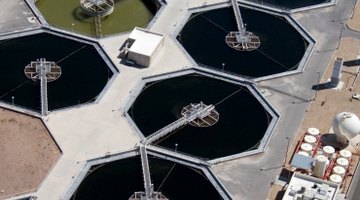How to Capture Methane Gas From a Septic System for Energy
Harnessing the methane that is produced in septic systems holds great untapped potential. Called anaerobic digester gas (ADG) -- because it is produced by breaking down sewage sludge or other organic material in the absence of oxygen -- is a mixture of about half methane and 30 percent carbon dioxide that is usually flared, or burned, to mitigate environmental damage. However, by redirecting the captured methane-rich gas for use as a viable source of heat and fuel for the waste water management facility, sewage treatment plants can displace fossil fuel use and lower greenhouse gas emissions in a cost-effective manner.

Harnessing the methane that is produced in septic systems holds great untapped potential. Called anaerobic digester gas (ADG) -- because it is produced by breaking down sewage sludge or other organic material in the absence of oxygen -- is a mixture of about half methane and 30 percent carbon dioxide that is usually flared, or burned, to mitigate environmental damage. However, by redirecting the captured methane-rich gas for use as a viable source of heat and fuel for the waste water management facility, sewage treatment plants can displace fossil fuel use and lower greenhouse gas emissions in a cost-effective manner.
Things You Will Need
- Continuous supply of waste water sludge
- An anaerobic digester system composed of a power generator, such as reciprocating engine, fuel cell or microturbine
- Storage device
- Concrete tank containing anaerobic bacteria
- Gas collection and transportation equipment
-
Take the sludge, or the organic matter that has settled out of waste water. Instead of discarding it, send it to an anaerobic digester to produce methane.
-
Store the sludge in a tank, followed by thickening it and then heating the sludge before it enters the digester.
-
Allow the anaerobic bacteria in the sludge digestion tank to work on the sludge, which releases methane.
-
Collect the methane in a gas holder and then pre-treat the gas before use to remove impurities.
-
Feed the treated methane gas into a prime mover that produces electricity.
-
Adapt the existing machinery to use the captured methane gas.
-
Redirect some of the electricity produced to power the earlier step of heating the sludge.
-
Use the rest of the power to run the other electrical needs of the waste water facility.
Warning
Working with anaerobic digester gas poses a safety risk, in that the container in which digestion takes place generates hydrogen sulfide and ammonia that could immediately harm anyone entering the tank. Prior to entry, the container must be cleaned and vented.
References
Writer Bio
Timothea Xi has been writing business and finance articles since 2013. She has worked as an alternative investment adviser in Miami, specializing in managed futures. Xi has also worked as a stockbroker in New York City.
Photo Credits
- Thinkstock Images/Comstock/Getty Images
- Thinkstock Images/Comstock/Getty Images
More Articles



